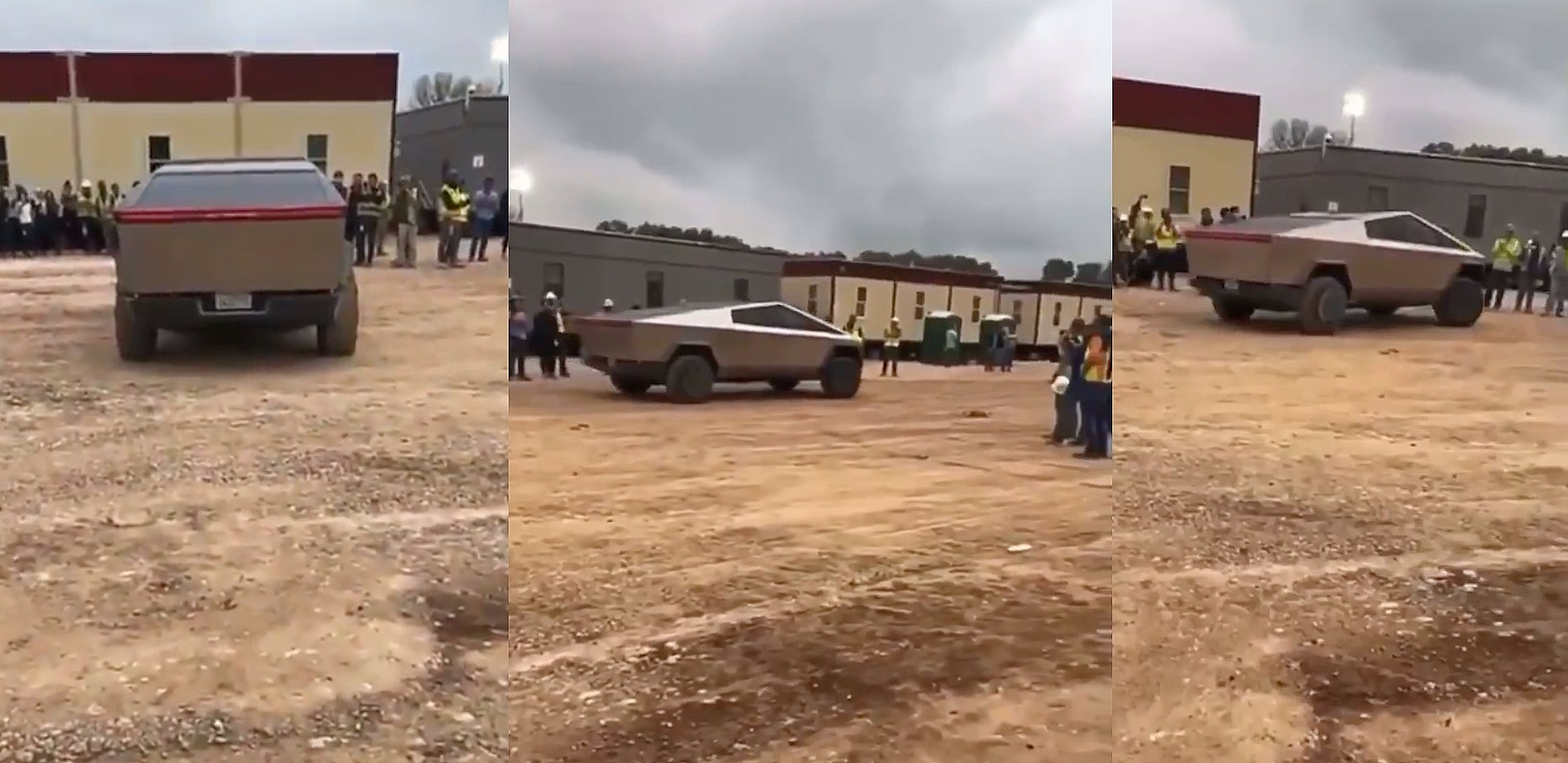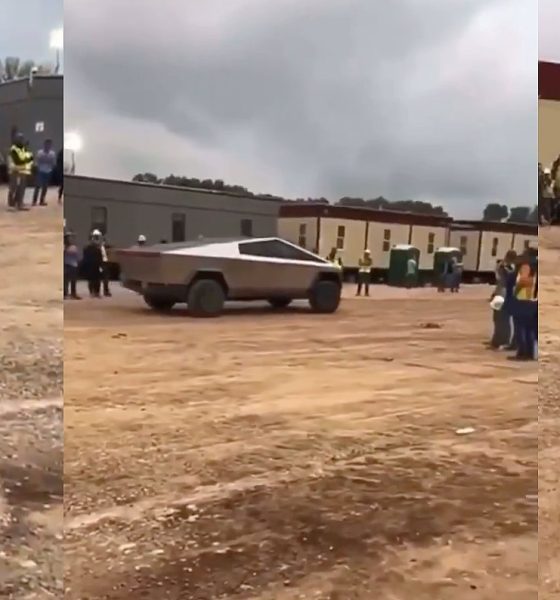

News
Tesla Cybertruck looks like CGI in real life in Giga Texas footage
Elon Musk has remarked in the past that the Tesla Cybertruck looks like a CGI render in real life. Based on actual footage taken of the all-electric vehicle during its visit to Giga Texas, it does seem like the CEO is right on the money. The Cybertruck may be made of tangible, cold steel, but from a distance, it almost looks like it belongs in the auto industry’s uncanny valley.
More footage of the Cybertruck from its previous Giga Texas visit earlier this month continues to be shared on social media. These include the Cybertruck traveling around the facility and videos of the vehicle backing up while surrounded by Giga Texas’ workers. And just as stated by Elon Musk, there are angles when the Cybertruck looks unreal even as it moves about.
Cybertruck spotted at GigaTexas, backing up!!
It looks so big @elonmusk ! pic.twitter.com/r2pZZctQxY— Gail Alfar (@GailAlfarATX) April 30, 2021
This may be partly due to the vehicle’s strange shape, which is unlike any production car available today in the way that it uses flat metal and glass panels. Together with the vehicle’s unpainted steel surface, the Cybertruck gives the impression that it’s a vehicle that recently drove away from the set of a sci-fi flick.
And ultimately, this may be one of the reasons why the Cybertruck has become part of pop culture. There’s just something about the vehicle, after all, from its brutalist design to its unashamedly angular appearance, that makes it memorable. It’s not traditionally attractive like the next-generation Tesla Roadster, and one could even argue that it’s an ugly truck to a degree. But even those that deem the Cybertruck ugly would admit that its design is eye-catching and memorable.
This was definitely highlighted in the Cybertruck’s Giga Texas appearance. The all-electric pickup truck attracted a lot of attention from the factory’s workers, despite a good number of those workers likely owning pickup trucks themselves. Texas is pickup country, after all, with trucks comprising a good portion of the state’s overall auto sales.
I showed this clip to my neighbor. Should have seen the look on his face 🤯
.@elonmusk pic.twitter.com/tNuyDRgQvL— TREV PAGE (@Model3Owners) April 24, 2021
For the Cybertruck to be successful and disruptive like its siblings such as the Model 3 and Model Y, the vehicle would have to attract a good number of traditional pickup buyers. This would likely be slightly challenging considering its appearance, but Tesla is equipping the Cybertruck with features that would likely make it attractive even to conventional pickup buyers.
These include a 6.5-foot bed, a 14,000-lb towing capacity, and a tri-motor setup that allows it to travel from 0-60 mph in 2.9 seconds. Together with utility features like adaptive air suspension that makes loading cargo easier, and a generous 100 cu ft of storage, the Cybertruck would likely be able to match and perhaps even exceed some of today’s most popular pickup trucks.
Don’t hesitate to contact us for news tips. Just send a message to tips@teslarati.com to give us a heads up.

News
Elon Musk’s Grokipedia surges to 5.6M articles, almost 79% of English Wikipedia
The explosive growth marks a major milestone for the AI-powered online encyclopedia, which was launched by Elon Musk’s xAI just months ago.

Elon Musk’s Grokipedia has grown to an impressive 5,615,201 articles as of today, closing in on 79% of the English Wikipedia’s current total of 7,119,376 articles.
The explosive growth marks a major milestone for the AI-powered online encyclopedia, which was launched by Elon Musk’s xAI just months ago. Needless to say, it would only be a matter of time before Grokipedia exceeds English Wikipedia in sheer volume.
Grokipedia’s rapid growth
xAI’s vision for Grokipedia emphasizes neutrality, while Grok’s reasoning capabilities allow for fast drafting and fact-checking. When Elon Musk announced the initiative in late September 2025, he noted that Grokipedia would be an improvement to Wikipedia because it would be designed to avoid bias.
At the time, Musk noted that Grokipedia “is a necessary step towards the xAI goal of understanding the Universe.”
Grokipedia was launched in late October, and while xAI was careful to list it only as Version 0.1 at the time, the online encyclopedia immediately earned praise. Wikipedia co-founder Larry Sanger highlighted the project’s innovative approach, noting how it leverages AI to fill knowledge gaps and enable rapid updates. Netizens also observed how Grokipedia tends to present articles in a more objective manner compared to Wikipedia, which is edited by humans.
Elon Musk’s ambitious plans
With 5,615,201 total articles, Grokipedia has now grown to almost 79% of English Wikipedia’s article base. This is incredibly quick, though Grokipedia remains text-only for now. xAI, for its part, has now updated the online encyclopedia’s iteration to v0.2.
Elon Musk has shared bold ideas for Grokipedia, including sending a record of the entire knowledge base to space as part of xAI’s mission to preserve and expand human understanding. At some point, Musk stated that Grokipedia will be renamed to Encyclopedia Galactica, and it will be sent to the cosmos.
“When Grokipedia is good enough (long way to go), we will change the name to Encyclopedia Galactica. It will be an open source distillation of all knowledge, including audio, images and video. Join xAI to help build the sci-fi version of the Library of Alexandria!” Musk wrote, adding in a later post that “Copies will be etched in stone and sent to the Moon, Mars and beyond. This time, it will not be lost.”
News
Tesla Model 3 becomes Netherlands’ best-selling used EV in 2025
More than one in ten second-hand electric cars sold in the country last year was a Tesla Model 3.

The Tesla Model 3 became the most popular used electric car in the Netherlands in 2025, cementing its dominance well beyond the country’s new-car market.
After years at the top of Dutch EV sales charts, the Model 3 now leads the country’s second-hand EV market by a wide margin, as record used-car purchases pushed electric vehicles further into the mainstream.
Model 3 takes a commanding lead
The Netherlands recorded more than 2.1 million used car sales last year, the highest level on record. Of those, roughly 4.8%, or about 102,000 vehicles, were electric. Within that growing segment, the Tesla Model 3 stood far ahead of its competitors.
In 2025 alone, 11,338 used Model 3s changed hands, giving the car an 11.1% share of the country’s entire used EV market. That means more than one in ten second-hand electric cars sold in the country last year was a Tesla Model 3, Auto Week Netherlands reported. The scale of its lead is striking: the gap between the Model 3 and the second-place finisher, the Volkswagen ID3, is more than 6,700 vehicles.
Rivals trail as residual values shape rankings
The Volkswagen ID.3 ranked a distant second, with 4,595 used units sold and a 4.5% market share. Close behind was the Audi e-tron, which placed third with 4,236 registrations. As noted by Auto Week Netherlands, relatively low residual values likely boosted the e-tron’s appeal in the used market, despite its higher original price.
Other strong performers included the Kia Niro, the Tesla Model Y, and the Hyundai Kona, highlighting continued demand for compact and midsize electric vehicles with proven range and reliability. No other model, however, came close to matching the Model 3’s scale or market presence.
News
Tesla Model Y Standard Long Range RWD launches in Europe
The update was announced by Tesla Europe & Middle East in a post on its official social media account on X.

Tesla has expanded the Model Y lineup in Europe with the introduction of the Standard Long Range RWD variant, which offers an impressive 657 km of WLTP range.
The update was announced by Tesla Europe & Middle East in a post on its official social media account on X.
Model Y Standard Long Range RWD Details
Tesla Europe & Middle East highlighted some of the Model Y Standard Long Range RWD’s most notable specs, from its 657 km of WLTP range to its 2,118 liters of cargo volume. More importantly, Tesla also noted that the newly released variant only consumes 12.7 kWh per 100 km, making it the most efficient Model Y to date.
The Model Y Standard provides a lower entry point for consumers who wish to enter the Tesla ecosystem at the lowest possible price. While the Model 3 Standard is still more affordable, some consumers might prefer the Model Y Standard due to its larger size and crossover form factor. The fact that the Model Y Standard is equipped with Tesla’s AI4 computer also makes it ready for FSD’s eventual rollout to the region.
Top Gear’s Model Y Standard review
Top Gear‘s recent review of the Tesla Model Y Standard highlighted some of the vehicle’s most notable features, such as its impressive real-world range, stellar infotainment system, and spacious interior. As per the publication, the Model Y Standard still retains a lot of what makes Tesla’s vehicles well-rounded, even if it’s been equipped with a simplified interior.
Top Gear compared the Model Y Standard to its rivals in the same segment. “The introduction of the Standard trim brings the Model Y in line with the entry price of most of its closest competition. In fact, it’s actually cheaper than a Peugeot e-3008 and costs £5k less than an entry-level Audi Q4 e-tron. It also makes the Ford Mustang Mach-E look a little short with its higher entry price and worse range,” the publication wrote.








